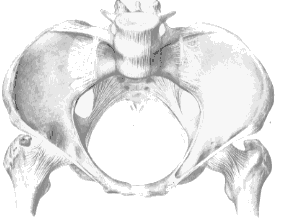Framework: The Pelvis
Made famous by none other than Elvis, the pelvis serves as an attachment for
the abdominal muscles that help control breathing. This bowl-like structure
is actually made of several fused bones. You can feel some of them just by
pressing your fingers against the "hip bones", which are really
your iliac crests, the top of the ilium bone. The bones are
paired on either side of the sacrum (check it out in the page on the spine).In
the front is the pubic bone (just under the pubic hair) and the pubic
symphysis where the two sides meet.
In the back, at the bottom is the ischium, which you may recognize from the iscial tuberosity, the bones you feel when you sit up, sometimes called the "sitting bones". The actual hip socket happens at the joint of the three major bones, and creates a "ball and socket" type joint with the greater trochanter of the thigh bone or femur.

This is the female pelvis, and features a wider, rounder shape than the male
pelvis below. This is needed for childbirth. You can also see how the iliac
crests (the sides) flare out wider than they do in the male pelvis. In the
centre are the bottom two lumbar vertebrae, and in the front you can see the
pubic symphesis which is really a ligament. Hormonal changes at childbirth
relax this ligament, allowing it to stretch.

The male pelvic bones are actually thicker and heavier than the female bones.
The outlet (the space in the bottom) is narrower and smaller, with the sacrum
more curved.
Back to The Journey of the Voice
Back to The Framework
On to Respiration...
More on the pelvis...
The definitive, classic anatomical text, available from Bartelby.com
- go more indepth on the structure at the core of your body.
Henry Gray (1821–1865). Anatomy of the Human Body,
6c. 2. The Pelvis

